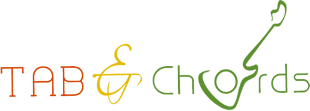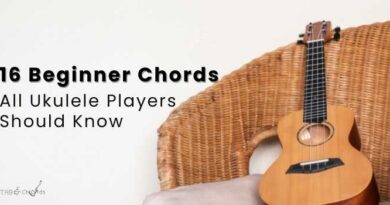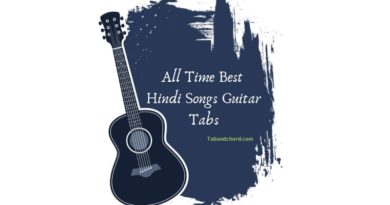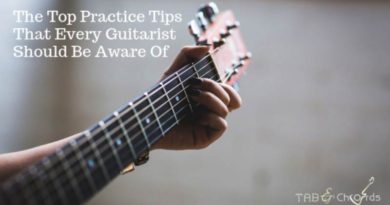4 Effective Ways to Practice Guitar
Practicing the guitar helps you achieve your goals. When we set goals we progress towards mastering the guitar or a key music theory concept on the instrument. Goals drive our focus toward an outcome. The key to learning the guitar is having consistent practice sessions. This is how you progress. This is how the guitar is learned. Let’s take a look at 4 ways to practice the guitar.
1. Warm-Up Exercises
A simple chromatic exercise can help your hand and fingers find their place on the fretboard. These exercises are meant to allow your fingers to move in small increments, adjusting your fingers to the guitar fretboard. Check out the 2 exercises below. These are very common chromatic scale movements to help you warm up on the guitar.
Example #1: Ascending Chromatic
e|———————————————————1-2-3-4-|
B|———————————————–1-2-3-4——-|
G|———————————–1-2-3-4————-|
D|————————1-2-3-4———————|
A|————-1-2-3-4—————————–|
E|–1-2-3-4————————————-|
Example #2: Descending Chromatic
e|–4-3-2-1————————————-|
B|————-4-3-2-1—————————–|
G|———————–4-3-2-1———————|
D|———————————-4-3-2-1————-|
A|———————————————4-3-2-1——-|
E|——————————————————–4-3-2-1-|
Play these scale patterns on any fret, at any speed. They create a mechanism for warming up and letting your hands get used to the distance between the frets.
Practicing is the process of taking a task that seems difficult and doing it repeatedly, over days and weeks until you are able to do it well and easily.Ron Ottley
2. Scales and Arpeggios
A core focus to practicing the guitar is playing scales and arpeggios. A scale is a sequence of notes played in a given key. An arpeggio is a series of notes highlighting a given chord. These note combinations give guitarists a color pallet of tones to paint a melodic painting in songs, improvisations and song craft. Here are some great ways to practice scales and arpeggios:
Exercise #1:
e|————————————————–7-8-10-8-10-12-10-12-13-|
B|————————————–8-10-12————————-|
G|————————–7-9-10-9———————————-|
D|—————-7-9-10—————————————–|
A|——-7-8-10———————————————–|
E|8-10——————————————————|
Arpeggios will highlight the core notes of a chord, such as CMaj7. The notes in CMaj7 are C-E-G-B.
Exercise #2:
e|————————-2-3-|
B|——————-1-5—–|
G|————-0-4———|
D|——-2-5————-|
A|-3-7——————-|
E|———————–|
Developing a practice routine that consists of scales and arpeggios is essential for all guitarists. You can rotate from key to key and play each major scale, mode and arpeggio for the key you are practicing in. For example:
Key of C
CDEFGAB (major scale)
Arpeggio Rotation:
C maj, D min, E min, F maj, G7, Am, B dim
As you practice playing scales and arpeggios, you can use a metronome or a drum track to stay on beat. Practice playing scales and arpeggios on the on beat & the off beat.
3. Chord Progression Practice
One of the best ways to practice on the guitar is chord transitions and progressions. Chords are the most essential component to learn because they exist in every song. Chord progressions create a sense of movement in a musical setting. Some of our favorite songs can be recognized by the chord progressions, like the progression for Back In Black by AC/DC. The tune is immediately recognizable. Here are some basic chord progressions you can add to your routine:
Progression 1: I – vi – IV – V
G – Em – C – D
Progression 2: I – vi – ii – V
G – Em – Am – D
Progression 3: I – V – vi – IV
G – D – Em – C
Transposing Chord Progressions:
Chord progressions can be changed into different keys, changing the focus of the key to a new key. For example, If you are playing G,C,D, you can transpose this progression to the key of C by changing the tonal center: C,F,G. The chord progression we are playing is 1,4,5. Aligning the numbers to the key you are playing in will allow you to transpose the chords to any piece of music.
Chords in C Major:
- I: C
- IV: F
- V: G
Chords in G Major:
- I: G
- IV: C
- V: D
The wise musicians are those who play what they can master.Duke Ellington
4. Learning Songs
Choosing the right songs for your skill level is important for successful learning. If you learn a song that is above your skills, then you risk getting discouraged and stopping. If you are a beginner, try learning songs that use basic chords like C major, A minor, F major and G7. As you learn basic chords it is important to pair those basic chords to songs that use them so you can see the practical application of chords.
Breakdown songs into manageable sections. Get used to learning small chunks of each song. One of the best ways to learn songs is to start with the intro, then learn the verses, chorus and bridge. If you are learning more intermediate techniques you can then tackle learning sections of a guitar solo.
The benefits of learning a full song. Learning full songs gives guitar players insights on how professional guitarists write and structure songs. By learning full songs we can learn new types of chord progressions and play them to our own practice routine. Learning from others is the best way to master the fretboard. Last week I learned how to play a Ray Charles song on the guitar, By doing this I was exposed to new chord progressions that I normally wouldn’t have voiced on the guitar.
Mastering these 4 areas will help you create a solid practice routine and expand your musical vocabulary. Consistency is the key to practicing the guitar
Bio:

Host of the Guitar Freaks Podcast
Justin is a Blues guitarist from Utah. He created a guitar learning tool called the FretDeck on Kickstarter that has helped many guitar players master the fretboard. He is also the host of the Guitar Freaks Podcast.
Download Free Guitar Charts
website link: www.guitarfreaksblog.com
Best,
Justin Comstock



